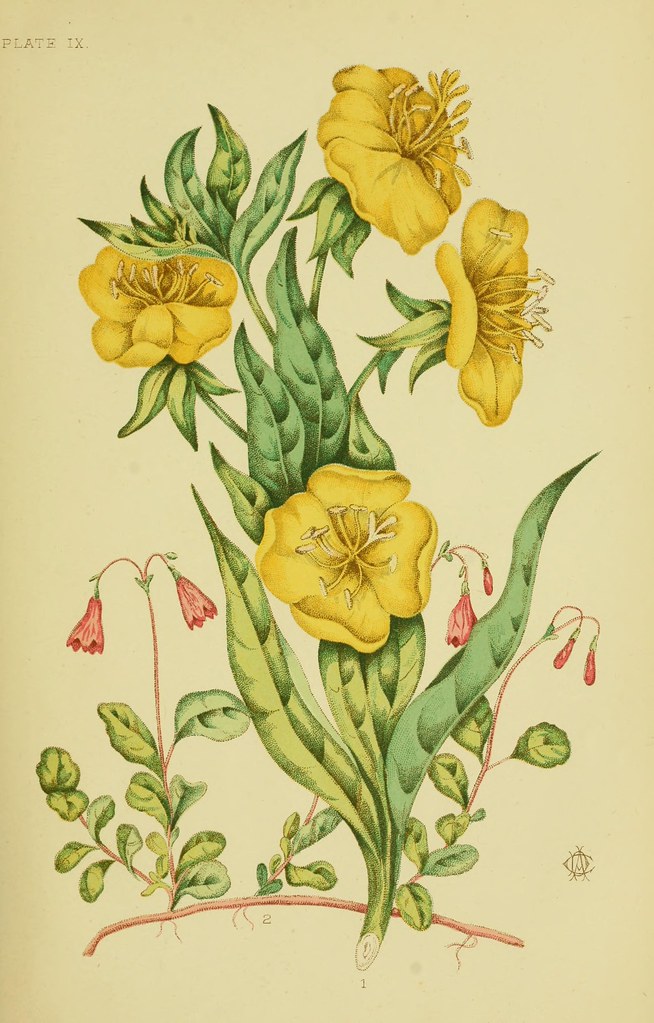#oenothera biennis
Explore tagged Tumblr posts
Text
My Oenothera biennis at home is covered in caterpillars of white-lined sphinx moth. I've never seen one before! I think the caterpillars hibernate underground over the winter and emerge in spring as their adult moth form?
O. biennis is common evening-primrose. It has such a special place in my heart. It was, I believe, the first rescued plant that bloomed for me—I pulled one from a crack in the pavement on the roadside, not knowing what it was, and carefully took care of it until it had grown too big for its pot, at which point I planted it in the front flower bed.
I remember how amazing it was to watch the plant develop pointed buds that opened into large, bright, delicate flowers that were the most gorgeous shade of glowing pale yellow. It was so unlike the rich, heavy, buttery yellows of dandelions and sunflowers and other yellow flowers I was familiar with—this plant had its own yellow, so gentle yet so luminous, almost fluorescent. Each day, a new set of buds formed and opened, beginning late July and continuing into the final days of September.
At last, the plant reached the end of its bright, showy riot of blossoms, and slowly dried up entirely, leaving an array of partially split open seed pods along the stem. O. biennis is biennial, as the name suggests. It germinates the first year, forms a rosette of leaves close to the ground, then the second year, it bolts—rapidly growing its stem upward—and produces tons and tons of flowers until it is utterly spent. As the plant dries out in death, the seed pods slowly curl open, releasing loads of tiny seeds.
The next spring, a strange miracle occurred: Many O. biennis sprouts came up where the seeds had fallen, but instead of creating a neat little rosette of leaves on the ground, they began bolting immediately.
One particularly enthusiastic sprout was already a foot tall by May, and kept growing and growing, to my perplexment. "You're supposed to be biennial! What are you doing?"
But it couldn't be denied—the plants were all preparing to bloom the same year they'd first sprouted. And bloom they did!


The flower bed by the front door was blazing with color.
I saw how people designated O. biennis as a weed—it wasn't compact like the usual garden plants, it grew tall and sprawling like an expansive candelabra of blossoms. It was strong and enthusiastic in spite of poor conditions. But it was so beautiful, I was in love.
I learned that occasionally, O. biennis growing in harsh conditions with low competition, could evolve to have an annual life cycle. Apparently, all the seeds produced by the founding plant inherited this trait.
Yesterday, I visited home and collected seed pods from the one extraordinarily enthusiastic plant that had captured my attention, the one that bolted in spring and began blooming before all the others. I intend to spread those seeds in the goldenrod fields and whatever neglected place a tough plant might thrive.
I feel that the progeny of my one extraordinary plant might be more competitive in areas that are periodically subjected to mowing and bush-hogging. The plants these seeds give rise to could be better adapted to the novel stresses placed upon them in these disturbed environments.
The weakness of O. biennis is that it spreads its seeds simply by gravity and the action of water washing seeds away. Its genetics, however exceptional, cannot travel far. So I am helping it out a little bit, by identifying a plant that has evolved exceptionally well for the stresses of a roadside environment and spreading its seeds as much as I can.
571 notes
·
View notes
Text

Evening Primrose (Oenothera Biennis)
#photographers on tumblr#nature#flowers#autumn#yellow#floral#flores#otoño#amarillo#fall#evening primrose#oenothera biennis#evening star#sun drop#morning#dew#wildflowers#original photographers#original photography#vertical
121 notes
·
View notes
Text
My Garden Flowers Part 3
All photos mine. The small buttercup and evening primrose are edited for colour since the camera didn't catch it and washed it out.
In order of appearance:
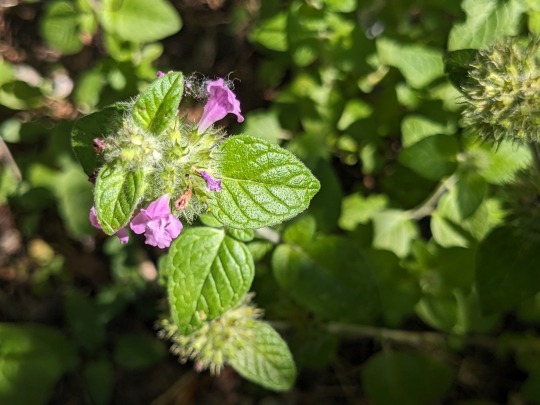
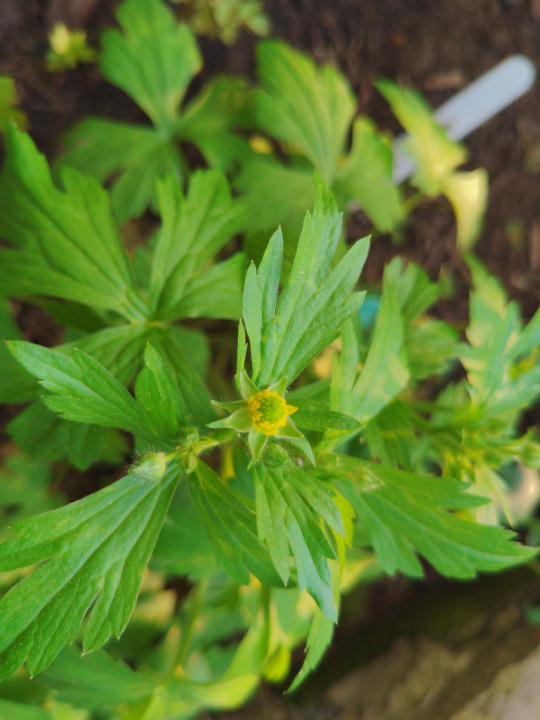
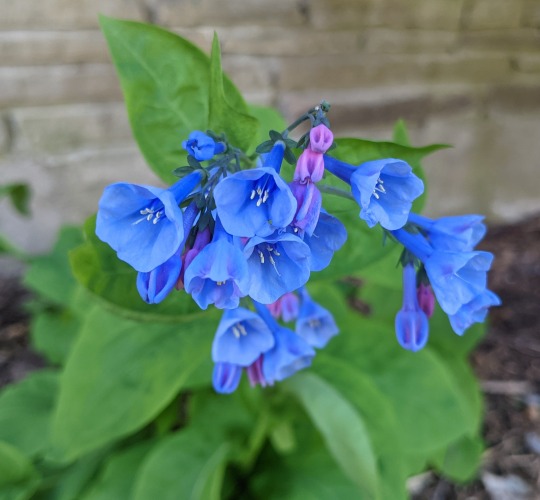

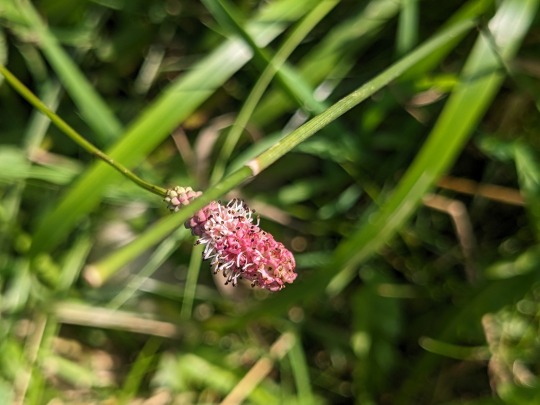
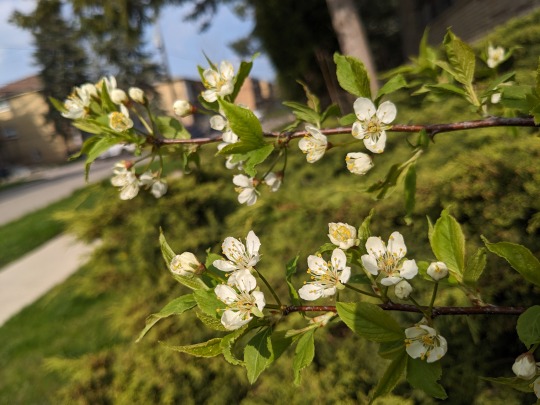

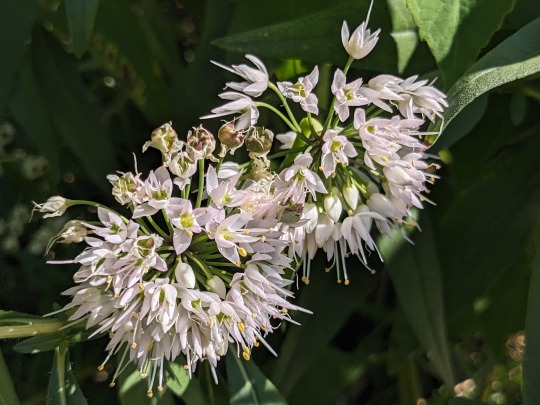
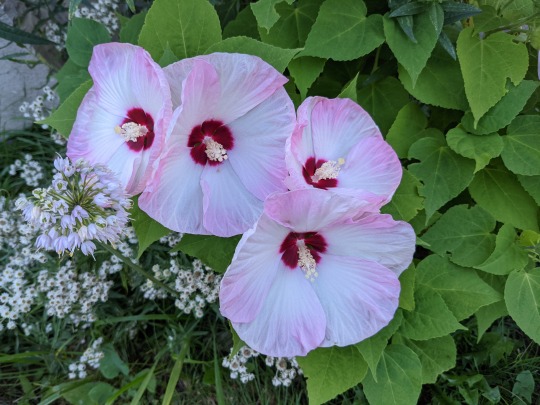
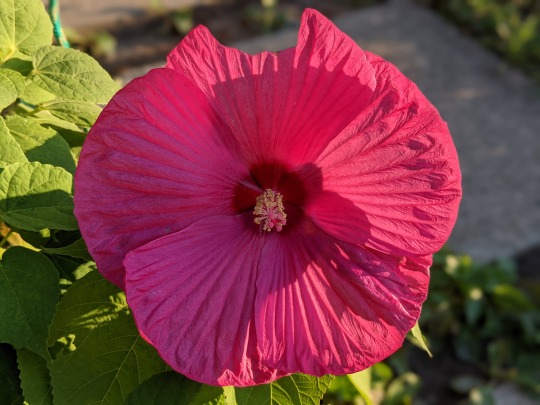
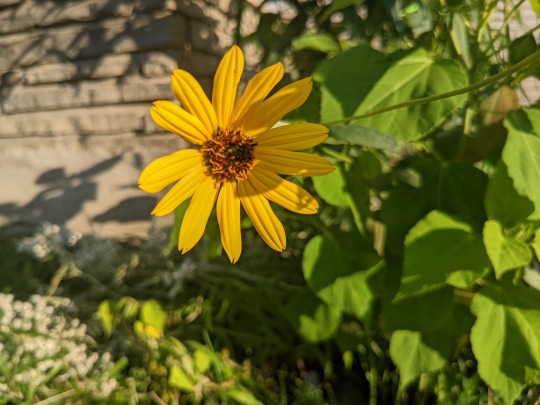
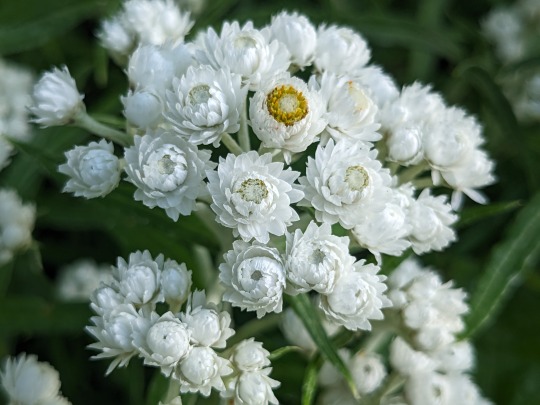
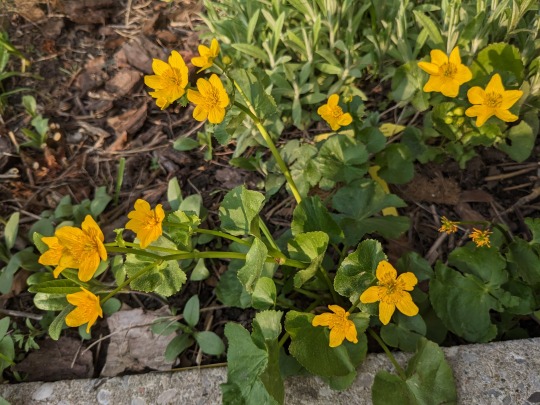
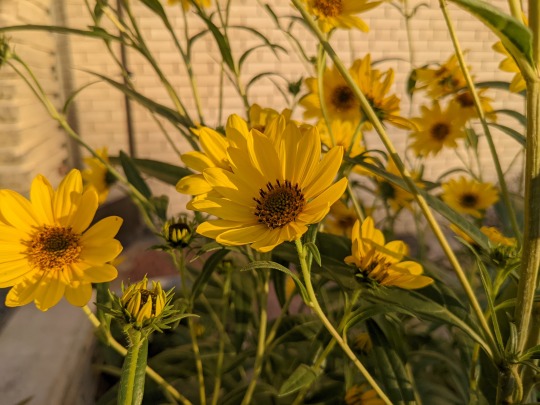
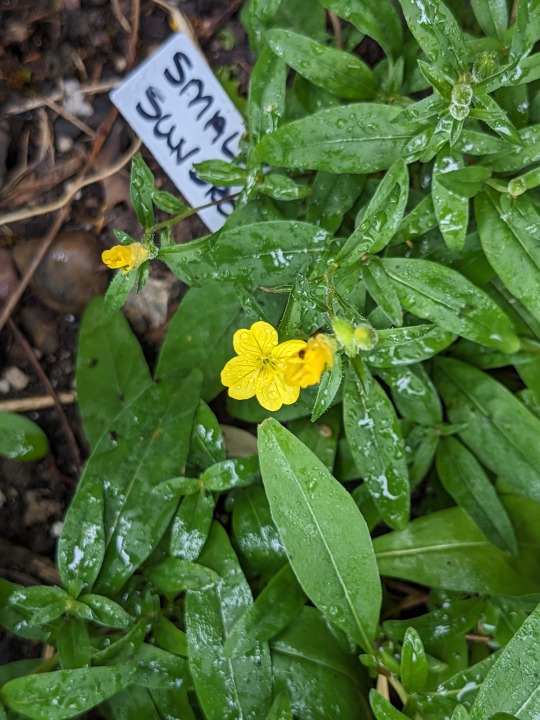
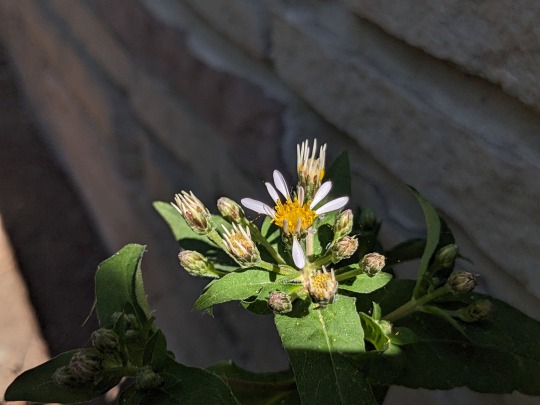
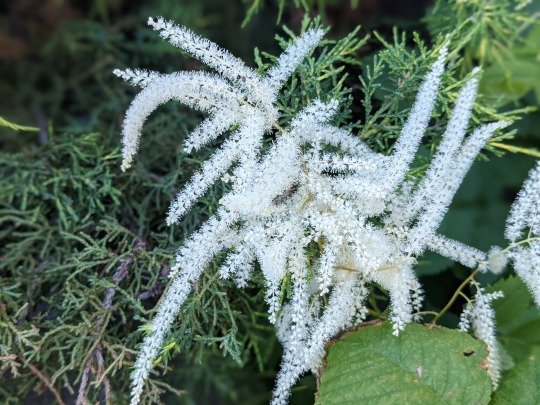
In order of appearance:
061. Wild Basil (Clinopodium vulgare) Didn't do so well the last place I had her in, but she seems happy in this spot, so fingers crossed.
062. Crested Iris (Iris cristata) Not pictured as she hasn't flowered yet.
063. Smallflower Buttercup (Rancunculus abortivus) Not much to look at compared with other buttercups but one of the only native buttercups with (limited) edible uses.
064. Smooth Solomon's Seal (Polygonatum biflorum) Not pictured as she hasn't flowered yet. Soon, hopefully!
065. False Solomon's Seal (Maianthemum racemosa) Not pictured as she hasn't flowered yet, but she's growing well so hopefully next year.
066. Blisterwort (Ranunculus recurvatus) I didn't plant that. She just turned up last year. Not pictured as I haven't got any pictures yet.
067. Fairy Spuds (Claytonia virginica) Not pictured as she hasn't flowered yet. She's a wee little spud in the ground.
068. Flowering Dogwood (Cornus floridus) Not pictured as she hasn't flowered yet but she is slowly spreading out.
069. Plantain-Leaf Sedge (Carex plantaginea) Not pictured as I haven't got pictures yet. I should. It's a neat plant. Evergreen, too!
070. Virginia Bluebells (Mertensia virginica) One of the prettiest plants I've ever seen, from the shape and texture of the leaves to the purplish pink buds to the bright blue bell-shaped flowers. They're spring ephemerals, though, so they're long gone by now. But will emerge next spring!
071. Evening Primrose (Oenothera biennis) Only lives for two years and reseeds itself. It's a common weed along sidewalks, but its flowers glow yellow in the evening and often remain in bloom at night.
072. Squirrel Corn (Dicentra canadensis) Not pictured as she hasn't flowered yet. The leaves are really cute, though.
073. Large Toothwort (Cardamine maxima) Not pictured as she hasn't flowered yet.
074. Wintergreen (Gaultheria procumbens) Not pictured as I haven't got any pictures yet.
075. Great Burnet (Sanguisorba officinalis) A cultivar, not sure which one. I'll get the wild type if/when I can.
076. American Plum (Prunus americana) I was not expecting her to flower this year! Hopefully she will next year too, and without aphids this time so I can have some plums. :)
077. Smooth Aster (Symphyotrichum laeve) So like I said, I do think New England asters are the prettiest of this genus, but smooth asters are very nice in their own way. Tender bluish leaves, and delicate light purple flowers.
078. Sweet Grass (Hierochloe odorata) Not pictured as I haven't got any pictures yet. She only flowered one year. Hasn't since. I won't miss a photo next time.
079. Nodding Onion (Allium cernuum) What's better than pretty flowers? Tasty pretty flowers!
080-081. Swamp Rose Mallow (Hibiscus moscheutos) Two different cultivars and the red one has died, but I did get my hands on the wild type! That will hopefully bloom this year.
082. Stiff Sunflower (Helianthus pauciflorus subrhomboideus) Holds her own against the much more aggressive Nuttall's sunflower. Sometimes called beautiful sunflower. I don't know how one decides which species of a very showy genus gets that name, but I guess she won out.
083. Pearly Everlasting (Anaphalis margaritacea) Another one that was hard to choose a photo of. You just hardly believe they're real!
084. Marsh Marigold (Caltha palustris) I planted her where there's a drip from the eavestrough so she can get very wet when it rains. :) She is not a marigold but instead part of the buttercup family.
085. Nuttall's Sunflower (Helianthus nuttallii) Whenever I am expressing frustration about sunflowers, it is almost always this species. lol Very beautiful but very aggressive.
086. Larkspur Violet (Viola pedatifida) Not pictured as she hasn't flowered yet.
087. White Turtlehead (Chelone glabra) Not pictured as she hasn't flowered yet.
088. Small Sundrops (Oenothera perennis) Not quite as intensely yellow as some of her relatives but still very bright.
089. Bigleaf Aster (Eurybia macrophylla) You generally grow her for foliage rather than her flowers, but flowering she is! Very drought-tolerant, but spreads more readily in less harsh conditions.
090. Bride's Feathers (Aruncus dioicus) Southern Ontario and surrounding area's evolution really went off on the lacy white flowers, and this species' flowers might be the laciest of them all.
#blackswallowtailbutterfly#my photos#photography#my garden#garden flowers#native plant gardening#native flowers of Carolinian Canada and USA#Viola sororia#Rancunculus abortivus#Mertensia virginica#Oenothera biennis#Sanguisorba officinalis#Prunus americana#Symphyotrichum laeve#Allium cernuum#Hibiscus moscheutos#Helianthus pauciflorus subrhomboideus#Anaphalis margaritacea#Caltha palustris#Helianthus nuttallii#Oenothera perennis#Aruncus dioicus
11 notes
·
View notes
Video
n5_w1150 by Biodiversity Heritage Library Via Flickr: The Language of flowers : London :F. Warne,[18--?] biodiversitylibrary.org/page/60674408
#Flower language#Flowers in literature#Chicago Botanic Garden#Lenhardt Library#bhl:page=60674408#dc:identifier=https://biodiversitylibrary.org/page/60674408#language of flowers#flowers#bouquet#flower#flickr#rose#chicory#virginia bluebells#rosa#Mertensia virginica#evening primrose#Common evening-primrose#Oenothera biennis#peony#paeony#Paeonia#blue daisy#Felicia amelloides#blue felicia#golden sage#Salvia officinalis
2 notes
·
View notes
Text
Ortica Simpatica, Oenothera Biennis
1 note
·
View note
Text

1 note
·
View note
Text

My dry-site prairie basket is coming right along. These are all narrow-rooted species that love full sun and fast drainage
From top clockwise:
Lanceleaf coreopsis (Coreopsis lanceolata)
Palid coneflower (Echinacea pallida)
Evening primrose (Oenothera biennis)
Tall green milkweed (Asclepias hirtella)
Center, my new favorite, Illinois bundle flower (Desmanthus illinoiensis)
#midwest native plants#native plants#container gardening#lanceleaf coreopsis#coreopsis lanceolata#pale purple coneflower#echinacea pallida#evening primrose#oenothera biennis#tall green milkweed#asclepias hirtella#illinois bundle flower#desmanthus illinoensis
1 note
·
View note
Text

Evening primrose, Oenothera biennis (1902-1908).
Watercolour.
The Wellcome Collection.
173 notes
·
View notes
Text


Oenothera biennis (evening-primrose)
Well it's official - today is the first day of autumn. In truth, there have been numerous warning signs, not the least of which is the absence of blossoms on this evening-primrose. A month ago this plant was festooned with yellow flowers but now, only a few remain.
Wildflowers that aim to attract bees are usually yellow or purple, because these are the colors that a bee's eyes are most sensitive to. Butterfly-pollinated flowers tend to be pink or red for the same reason. Logically, moth-pollinated plants usually have white flowers (easier to see in the dark) or strongly-scented blossoms like honeysuckle. Orange honeysuckle is pollinated by hummingbirds and this explains its bright color.
As for me, I'm getting out my scarf and wooly mittens, because as autumn advances (just like this evening-primrose) we all know what's coming next.
#flowers#photographers on tumblr#evening-primrose#first day of autumn#wildflowers#fleurs#flores#fiori#blumen#bloemen#Crescent Beach#Vancouver
95 notes
·
View notes
Text
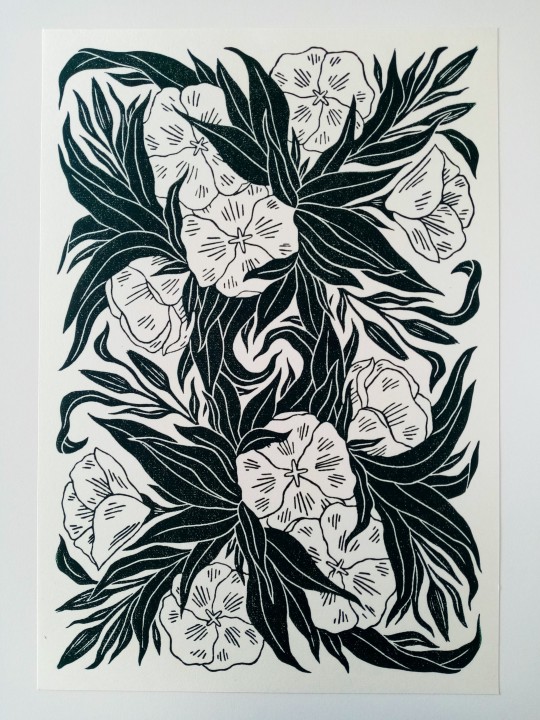
Haven't posted in a while, I've been working on a few bigger blocks and this is one of them: an A4-size symmetrical evening primrose (oenothera biennis) design, printed in dark green. I reread Maurice for the dozenth time in a moment of weakness and the floral symbolism got to me. Darkness in Maurice signifies nature, truth, growth, and understanding; the repeated reference to this night-blooming flower is exemplary of that theme. (Don't get me started!)
#do they even look like primroses? don't answer that#i should make another block to make the flowers yellow/gold but i don't want to.#linocut#relief print#blockprinting#printmaking#floral#evening primrose#maurice
45 notes
·
View notes
Text

Canadian Goldenrod Part 1:
While the world’s finest athletes were going for gold in Paris at the 2024 Olympic games this summer, I was going for gold in my own garden. By “gold”, I mean this gorgeous Canadian Goldenrod (Solidago canadensis) plant.
If there was a plant Olympics, Canadian Goldenrod could win a gold medal in the invasive species category. This large and in-charge plant has numerous attributes that enhance its successful invasion of new habitats. Canadian Goldenrod is a herbaceous perennial plant that can grow up to 6 feet (180 cm) tall, a height which gives its airborne seeds an advantage in travelling to new areas far from the parent plant. The plant propagates via underground rhizomes that produce vast genetically identical populations that can take over an area. This species will eagerly take over habitat disturbed by natural disasters like forest fires as well as areas disturbed by human activity before other plant species can establish a foothold.
A resilient plant, Canadian Goldenrod can thrive in a wide range of climates corresponding to the USDA hardiness zones 3 through 9. Even in its native habitat northeastern and north-central North America, the plant will form natural monocultures where it has out-competed the other indigenous plants.
What happens when this plant goes to compete with native plants in other parts of the world? Find out next time.
Please note: The large bushy plant I am hugging is the Canadian Goldenrod. The other yellow flowers are a different species called Evening Primrose (Oenothera biennis).
#katia plant scientist#botany#plant biology#plants#plant science#plant identification#yellow flowers#flowers#gardening#invasive species#invasive plants#canada#north america#canadian goldenrod#goldenrod#wildflowers#cottage garden#gardencore#flowercore#cottagecore#biology#ecology
14 notes
·
View notes
Text
Wow!!! Searched Oenothera biennis on JSTOR and it turns out that this species is well known to evolve annual variants.
It seems like O. biennis is frequently used in studies of evolution.
Anyway, it's really cool to me that my O. biennis are all annual variants, because it makes me wonder what evolutionary pressures could have caused this variation to arise. The progenitor plant I found growing in a crack in the pavement on the roadside. Could lawn and sidewalk maintenance have selected for rapid life cycles? Or is it just the harshness of the environment?
It's so cool to see a clear way that human-made environments cause plants to evolve.
#plants#ecosystems#evolution#native plant gardening#oenothera biennis#native plants#gardening#ecology
112 notes
·
View notes
Text
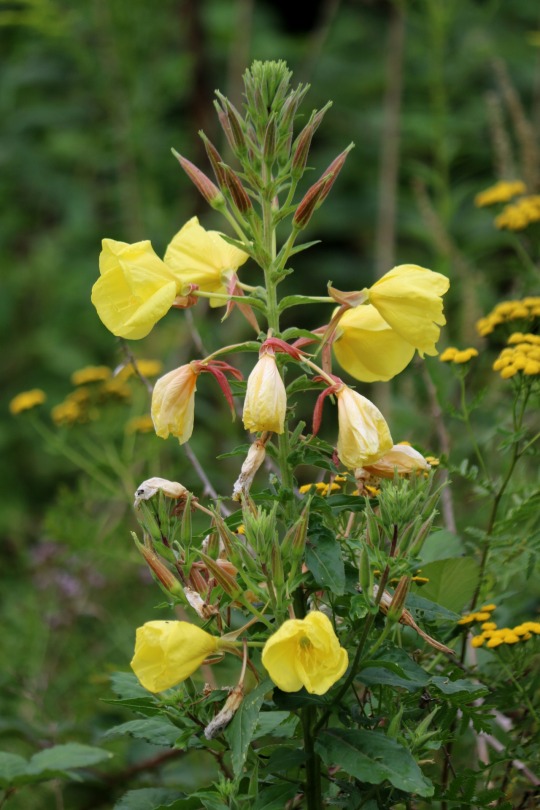
Evening Primrose (Oenothera Biennis)
#photographers on tumblr#nature#flowers#summer#yellow#floral#flores#verano#amarillo#oenothera biennis#evening primrose#evening star#sundrop#wildflowers#vertical#original photographers#original photography
149 notes
·
View notes
Text
My Garden Flowers Part 9
All photos mine.










In order of appearance:
241. Wild Yam (Dioscorea villosa) Not pictured as she hasn't flowered yet.
242. Nodding Wakerobin (Trillium flexipes) Not pictured as she hasn't flowered yet.
243. Moss campion (Silene acaulis) Not pictured as she hasn't flowered yet.
244. Great White Trillium (Trillium grandiflora) Not pictured as she hasn't flowered yet.
245. Yellow Wood-Sorrel (Oxalis stricta) Small yellow flowers. You often find them growing as weeds, but they're native at least to the northern USA bordering southern Ontario. The leaves, flowers, and fruits are a very lovely snack, with a tart refreshing flavour.
246. Horseweed (Erigeron canadensis) A fairly common garden weed, but native so she can stay where she pops up from time to time. Not pictured as I haven't got pictures.
247. Stiff Goldenrod (Oligoneuron rigida) Not pictured as I haven't got pictures yet.
248. Fourflower Loosestrife (Lysimachia quadriflora) Not pictured as she hasn't flowered yet.
249. Smallflower Forgetmenot (Myosotis laxa) At least I think. Her flowers are certainly much smaller than the European pink and blue species I see around. Not sure what else she'd be.
250. Bearberry (Arctostaphylos uva-ursi) Not pictured as she hasn't flowered yet.
251. Tall Meadow-Rue (Thalictrum pubescens) Yet more lacy white flowers! I imagine if you preferred white you could have a full native garden of such.
252. Northern Bog Violet (Viola nephrophylla) Not pictured as she hasn't flowered yet.
253. Wool Grass (Scirpus cyperinus) Not pictured as she hasn't flowered yet.
254. Prairie Milkweed (Asclepias sullivantii) Not pictured as she hasn't flowered yet.
255. Square-Stemmed Monkeyflower (Mimulus ringens) More leggy than her yellow cousin, but still very attractive flowers that look a lot like snapdragons. She needs things moist.
256. Pawpaw (Asimina triloba) Not pictured as she hasn't flowered yet.
257. Meadow Sundrops (Oenothera pilosella) Not quite as intensely yellow as her cousins, Oenothera biennis and Oenothera fruticosa, but still very bright.
258. Wood Lily (Lilium philadelphicum) We don't have a ton of red or orange flowers native here as compared to yellow, white, or pink/purple flowers, so each one is a treat.
259. Virginia Waterleaf (Hydrophyllum virginianum) Yet more lacy white flowers! Not complaining, though, I think they're lovely in the garden. You find these growing in shaded woods.
260. Woodland Strawberry (Fragaria vesca) Unlike her cousin in the front, this one produces lots of berries...but they're white! That's not usual for the species but not unheard of. It's kind of fun to pick little white strawberries each year from that patch.
261. Pickerelweed (Pontederia cordata) Not pictured as she hasn't flowered yet.
262. Bog Rosemary (Andromeda polifolia) This is a cultivar. I will have the wild type one day.
263. Strict Blue-Eyed Grass (Sisyrinchium montanum) Her cousin in the front prefers things dry, but this one, like many members of her family (irises), prefers things moist. It was actually easier to get her to take than the dry one, though, which I had three failed attempts at before the one I planted last year.
264. Downy Yellow Violet (Viola pubescens) Not pictured as she hasn't flowered yet.
265. Purplestem Angelica (Angelica atropurpurea) Not pictured as she hasn't flowered yet.
266. Wrinkleleaf Goldenrod (Solidago rugosa) Not pictured as she hasn't flowered yet.
267. Purple Giant Hyssop (Agastache scrophulariifolia) Not pictured as I haven't got pictures yet.
268. Buffaloberry (Shepherdia canadensis) Not pictured as she hasn't flowered yet.
269. Silverberry (Elaeagnus commutata) Not pictured as she hasn't flowered yet.
270. White Lettuce (Nabalus albus) Not pictured as she hasn't flowered yet.
#blackswallowtailbutterfly#my photos#photography#my garden#garden flowers#native plant gardening#native flowers of Carolinian Canada and USA
13 notes
·
View notes
Video
n322_w1150 by Biodiversity Heritage Library Via Flickr: Studies of plant life in Canada;. Ottawa,A.S. Woodburn,1885.. biodiversitylibrary.org/page/11236128
#Canada#Plants#New York Botanical Garden#LuEsther T. Mertz Library#bhl:page=11236128#dc:identifier=https://biodiversitylibrary.org/page/11236128#HerNaturalHistory#Agnes Dunbar Moodie Fitzgibbon Chamberlin#WomenInScience#flickr#large evening-primrose#twin flower#enothera biennis#oenothera biennis#Common evening-primrose#linnea borealis#twinflower#botanical illustration#scientific illustration
1 note
·
View note
Text
Light
"No shadow without light"
Continuation to my short piece 'Darkness'.
_______________________________________________________
The darkness had taken over everything in the forest clearing, and nothing dared to move.
Not the animals, not the plants, not even the wind dared to stir a whisper.
In the midst of it all, there was a sinister figure exuding something darker than the darkness itself.
Darkness crouched over something, its teeth still clenched into the lifeless from.
Suddenly, the figure drew a deep breath, lifting its head up, but stopping abruptly as it had begun its motion.
Its black eyes remained fixed on lifeless brown ones, which were just moments ago filled with life until they filled with fear, and then... nothing. As if hypnotized, the figure ran its hand through the brown hair, leaning closer and closer in admiration.
Drawing a deep breath, the figure smells the lingering scent of fear in the air. Oh, such sweet fear.
The figure didn't know how long it had been in place, but suddenly it noticed a small amount of light reflecting from lifeless eyes.
Beautiful. The Darkness thought.
A small smile crept onto the figure's lips, stained with the dark blood, causing a somber drop to fall, hitting the lifeless eyes and obscuring the reflection of light.
The darkness lifted its gaze to the sky, noticing the moonlight peeking slightly from behind a cloud corner, reflecting the last lights of the evening in the square.
Beautiful. The darkness thought once again.
Rising to its full height, the figure was menacing, but with the moon reflecting light on the ground, the forest knew it could breathe, and a gentle breeze dared to move, dancing with the grass and leaves in its wake.
The darkness spread its black wings, threatening to engulf the light and stopping everything once again, but instead, the light increased, encouraging the wind to continue its nocturnal dance.
The darkness noticed the moon gently illuminating the edge of the forest, where small plants grew, Oenothera biennis, Evening Primrose, as if showing the way. He smiled at the moon as a sign of gratitude before bending its legs and leaning forward, channeling energy into its muscles. Then, with a powerful stroke, the wings swept downward and backward, propelling him into the air.
In the midst of the moonlight, the figure's movement appeared as a fleeting shadow, unnoticed by anyone, without fear. Although fear would be wise in the proximity of darkness. So no one and nothing noticed the swift movement as the figure grabbed hold of a small yellow flower.
When the light seemed too much for the shadow, he stopped in the darkest corner, staring directly into the light.
"Beautiful" the shadow whispered softly to himself.
In the midst of the light hums a young man, quietly toiling away in his backyard, tending to his plants. A gentle breeze catches onto the man's brown locks, swirling them a few times before heading towards the shadow, carrying an enticing scent with it.
Before the shadow could move, the man quiets down but continues his work.
The shadow closes his wings close to his body, making himself as inconspicuous as possible, crouches slightly, and starts creeping silently towards the young man until he is right behind his prey.
The young man turns around, smiling, his brown eyes full of light, looking straight into his black eyes. The shadow is slightly taken aback but smiles back as he straightens his back.
"Hi" the man says, taking a step towards the shadow fearlessly and placing his hand on shadows shoulder. The other hand of the shadow automatically wraps around the man's waist.
"Hi, my light" Eddie responds, slipping a Evening Primrose behind the mans ear.
"My Beautiful evening light."
#steddie#steve harrington/eddie munson#steve harrington#monster eddie munson#kas eddie munson#vampire eddie munson#darkness#steve is eddies evening light#stranger things
8 notes
·
View notes
